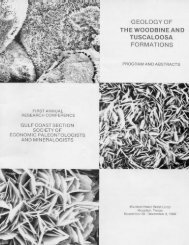Petroleum Systems of Deep-Water Basins - Gulf Coast Section SEPM
Petroleum Systems of Deep-Water Basins - Gulf Coast Section SEPM
Petroleum Systems of Deep-Water Basins - Gulf Coast Section SEPM
Create successful ePaper yourself
Turn your PDF publications into a flip-book with our unique Google optimized e-Paper software.
The Depositional Regime on the Abyssal Plain <strong>of</strong> the<br />
Congo Fan in Angola<br />
D.G. Evans<br />
WesternGeco<br />
London<br />
doug.evans@westerngeco.com<br />
Abstract<br />
The Miocene channel play <strong>of</strong> <strong>of</strong>fshore Angola contains the recent giant discoveries <strong>of</strong> Girassol, Dahlia, etc. From<br />
recent 3D surveys that extend across the salt front onto the abyssal plain in the Outer Congo Fan, it can be seen that<br />
this play can now be continued out into theultra-deep water into a new highly prospective frontier area. This presentation<br />
covers this area’s prospectivity and the use <strong>of</strong> the models generated here in the salt province.<br />
The Congo Fan <strong>of</strong> Angola shows evidence <strong>of</strong> extensive sand deposition from the Oligocene onwards. This sand<br />
deposition extends beyond the current exploration targets in the salt diapir province onto the abyssal plain, an area<br />
that has been covered by recent 3D seismic data sets.<br />
By using these data, the morphology <strong>of</strong> differing styles <strong>of</strong> sand deposition can be shown in a variety <strong>of</strong> ways<br />
including amplitude extraction, timeslices, opacity, and 3D visualisation. All these methods work well in this area<br />
because the strong amplitude/acoustic impedance contrast between sand and shale is combined with the approximately<br />
flat-lying nature <strong>of</strong> the abyssal plain. These factors allow the depositional morphologies to be shown without<br />
the influence or bias <strong>of</strong> interpretation.<br />
In this province <strong>of</strong> <strong>of</strong>fshore Angola, it can be also demonstrated that the Cretaceous and early Tertiary on the abyssal<br />
plain shows little or no seismic evidence <strong>of</strong> sand deposition. However, this section is a prime candidate to contain<br />
mature source rocks, the evidence for which can be demonstrated by the clear ‘DHIs’ seen in the overlying sands.<br />
Micro-faults that act as hydrocarbon migration conduits can be seen on the data.<br />
The abyssal plain is at first sight the ultimate location for the ‘subtle’ (i.e., stratigraphic) trap; however, closures<br />
can also be shown to exist as drapes over basement features and allochthonous salt bodies.<br />
The models generated on the abyssal plain can be applied in the far more heavily structured salt diapir province, to<br />
provide an understanding <strong>of</strong> the channel and fan systems in this area. The multiple DHIs here, combined with numerous<br />
sands and four-way dip closures suggest that this is a highly prospective area.<br />
20

















